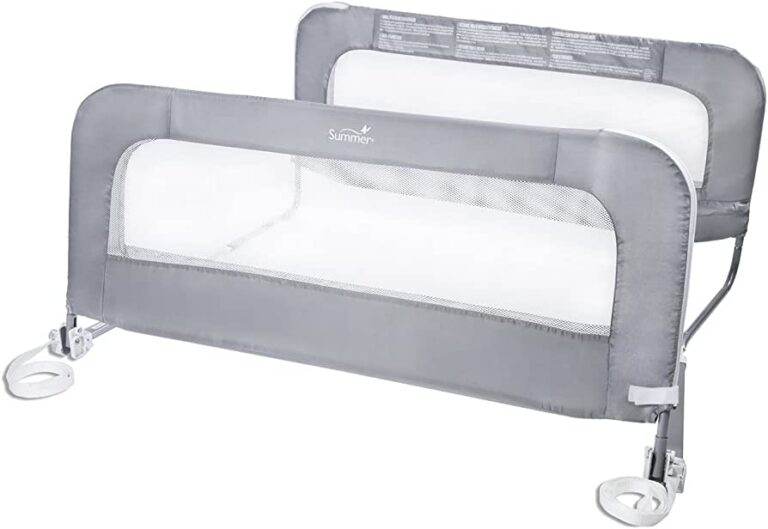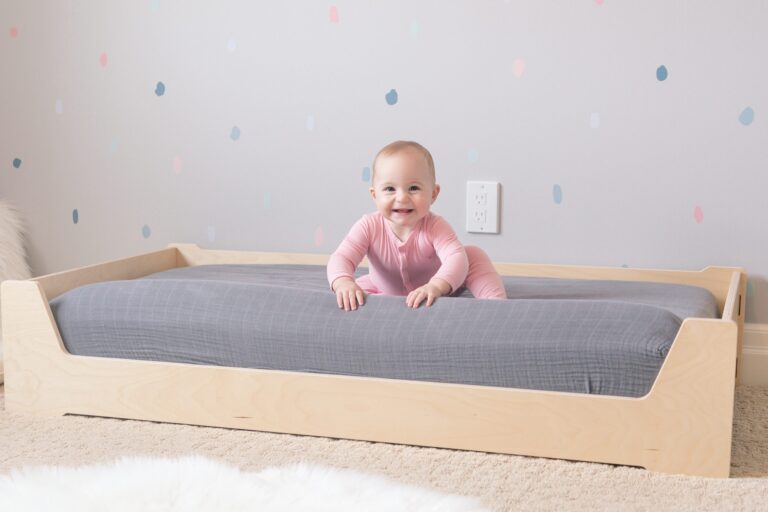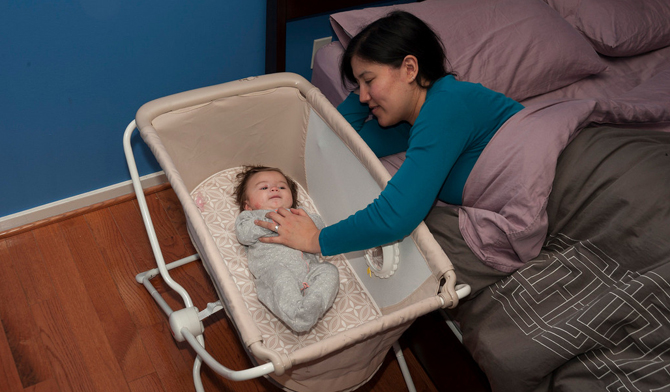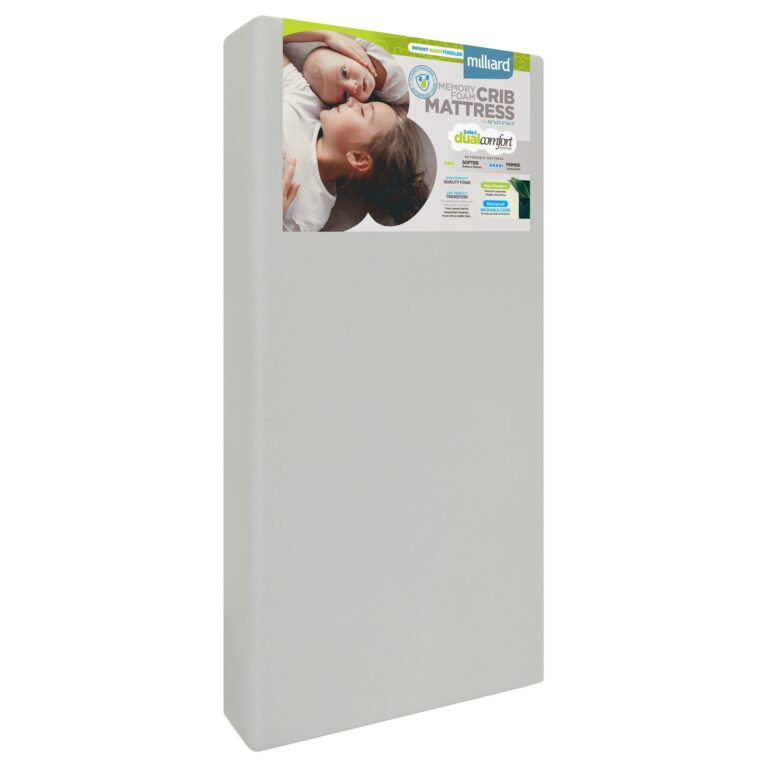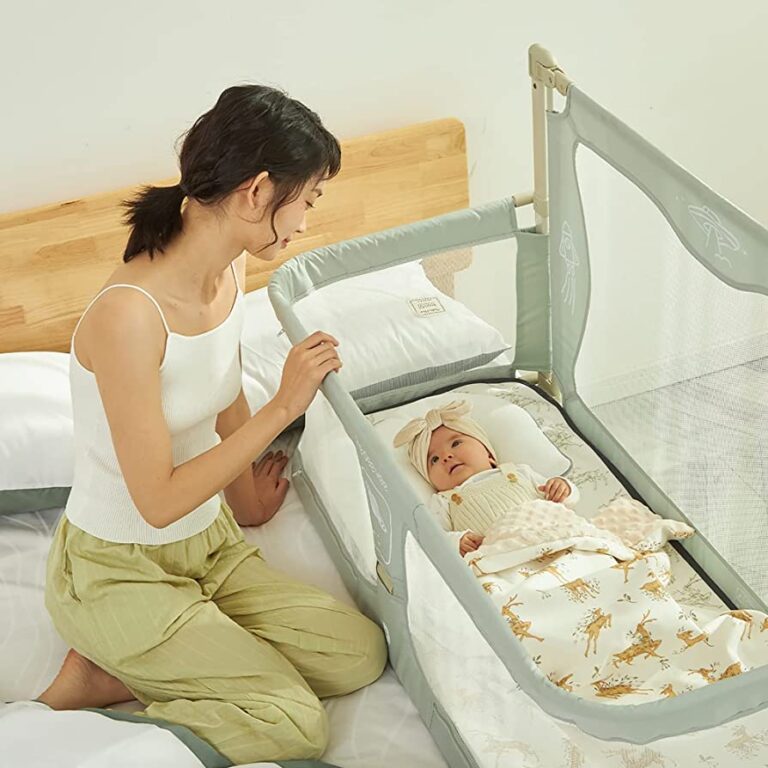Infant Bed Rail for Co-Sleeping
Infant bed rails are an invaluable safety tool for co-sleeping parents. They ensure that the baby is safe and secure, while providing a barrier between them and their parent during sleep. Infant bed rails can be installed on the sides of a crib, or attached to the side of an adult bed.
The rail should be tall enough to prevent any rolling over by either party in the middle of the night, but low enough to allow easy access when needed. When purchasing an infant bed rail, look for one made from durable material with no sharp edges or points where clothing could get caught and cause injury; it should also fit securely against both mattress and wall so as to not create any gaps which may lead to potential risks.
Co-sleeping with your infant can be a beautiful experience, but it can also carry certain risks. To reduce the chances of accidental falls and other dangers, consider investing in an infant bed rail for co-sleeping. These rails help to provide a secure boundary between you and your baby while they sleep, enabling both of you to get some restful sleep without worrying about safety issues.
Co Sleeping Bed Rail King Size
Cot Rail King Size beds are an ideal solution for families looking to provide a safe and secure sleeping environment for their child. The bed rail is designed to fit most king size beds, providing a sturdy barrier between the mattress and your little one. Its adjustable height allows you to customize it according to your needs, making sure that it can grow with your baby as they get older.
Additionally, its lightweight construction ensures easy setup and portability when traveling or visiting relatives. With this bed rail in place, parents can rest assured knowing their little one will be safe from rolling out of bed during the night!
Best Guard Rail for Co-Sleeping
When co-sleeping with your baby, it is important to use a guard rail that is specifically designed for co-sleeping. The best guard rails for this purpose are ones that fit securely around the bed and are made of high quality materials such as steel or wood. This will ensure that your little one stays safe and secure in their sleeping space while you both rest more comfortably.
Make sure to choose a guard rail that meets safety standards set by the Consumer Product Safety Commission (CPSC).
Baby Proof Bed Rail
A bed rail is a great way to baby proof your child’s bed and prevent them from rolling out while they are sleeping. Bed rails provide added security and peace of mind, as they can be easily attached to the side of the mattress with adjustable straps or hooks. They also come in various sizes, allowing you to find one that fits your child’s mattress perfectly.
Bed rails help keep babies safe by providing an extra barrier between their cribs and the floor, ensuring that even if they roll over during sleep, they will stay safely inside their beds.
Bed Rail for Queen for Co Sleeping
Co-sleeping is becoming increasingly popular, and if you’re looking for a way to make the experience safer for everyone involved, then a bed rail for queen beds may be the perfect solution. Bed rails are designed specifically to fit around queen size beds and provide an extra layer of protection while sleeping with your child. They allow easy access between parents and children at all times, while also providing safety from falls or rolling off the bed during sleep.
A bed rail is an affordable option that can help ensure a safe co-sleeping environment without sacrificing comfort or convenience.
Co Sleeping Bed Attachment
Co-sleeping bed attachments are a great option for parents who want to keep their baby close while they sleep. These attachments securely fit onto the side of an adult’s full-size bed, and can be used with any type of mattress, so parents don’t have to buy a new one. They provide extra stability and support for babies by creating a secure barrier between them and the parent, reducing the risk of rolling over or falling out of bed.
Additionally, co-sleeping bed attachments help both parents get more restful sleep since there is no need to worry about constantly checking on their baby throughout the night.
Bed Rail for Bed Sharing
Bed rails are an essential safety feature when it comes to bed sharing. They provide a barrier between two sleepers, helping to prevent one person from rolling off the mattress while they rest. Bed rails also help keep younger children safe in their parents’ beds, as they can be used to create a shallow barrier that prevents them from falling out of bed during the night.
Finally, bed rails can be helpful for those with mobility issues who may have difficulty getting into and out of bed without assistance – providing additional support for movement throughout the room.
Bed Rails for Toddlers
Bed rails are a great way to keep toddlers safe while they sleep. They help reduce the risk of falling out of bed and provide extra security for your little one. Bed rails come in various sizes and styles, so you can find the perfect fit for your child’s bed.
With adjustable heights, some models even feature a padded top rail, providing additional comfort and safety features. By using bed rails, you can give your toddler peace of mind knowing that he or she is secure at night.
Baby Proof Bed Frame
If you are a parent, baby proofing your bed frame is an important home safety step. Baby proofing your bed frame will help to ensure that young children do not become entrapped in the gaps between headboards and footboards or between the mattress and box spring. To baby proof a bed frame, use foam padding to fill any large gaps and install special guards on each corner of both the headboard and footboard.
These guards can be purchased at most hardware stores or online retailers.
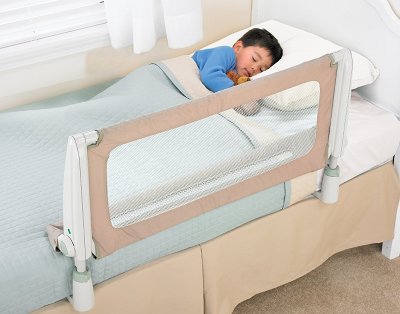
Credit: www.baby-sleep-advice.com
Can You Use a Bed Rail With a Baby?
Using a bed rail with a baby can be an excellent way to provide your little one with safety and security in their sleep space. Bed rails are designed to fit around the edges of beds, cribs or toddler beds, helping to keep your child from falling out when they’re sleeping. They come in different sizes and styles so you can find the perfect match for your mattress and frame.
When using a bed rail, make sure it is properly installed according to manufacturer’s instructions. You should also check the hardware regularly for any signs of wear or damage that could weaken its effectiveness. Additionally, never leave your baby unattended on elevated surfaces such as beds and never use pillows or other soft items inside the bed rail which may pose suffocation risks if accidentally covered by blankets or sheets during sleep.
At What Age Can a Child Sleep in Bed Without Rails?
When it comes to determining at what age a child can sleep in bed without rails, there is no one-size-fits-all answer as every child is different. Generally speaking, children should be able to stay in bed alone safely by the time they are two or three years old. However, some parents find that their kids may not be ready for this transition until they reach four or five years of age.
It’s important to remember that your little one’s safety must come first and foremost when deciding when he/she can sleep in bed without rails. If you have any doubts about his/her readiness for this change, then it’s best to wait until later on before making the switch. Additionally, even if your child is ready to make the transition from sleeping with rails around them, it may still be wise to keep a few pieces of furniture near the edges of the bed – such as nightstands or dressers – just in case he/she needs something during the night while sleeping without rails.
Ultimately, only you know what will work best for your family and whether your child is truly ready for this milestone!
How Can I Make My Bed Safe for Baby?
Making your bed safe for baby is an important step in creating a safe and comfortable sleeping environment. Start by using a firm mattress that meets safety standards, such as one with a waterproof cover to keep liquids from seeping into the mattress below. Additionally, use only lightweight blankets or sheets designed specifically for infants, so they won’t be too hot or uncomfortable during sleep.
Make sure pillows are kept away from baby’s face and avoid heavy comforters or quilts that can bunch up around baby’s head if he moves during the night. Place bumpers around the sides of the crib to prevent entrapment and make sure there is nothing else in the crib but pillow, sheets, and blanket that could potentially smother your little one. Lastly, practice good sleep habits like putting your baby down on his back for every nap and nighttime sleep to help reduce Sudden Infant Death Syndrome (SIDS).
By following these tips you can ensure a safe sleeping space for your little one!
What Age Can a Toddler Use a Bed Rail?
The age at which a toddler can use a bed rail varies depending on the individual child. Generally, most children should be able to safely use a bed rail between 18 months and three years of age. At this age, they are usually tall enough for the bed rail to fit properly and have developed greater control over their movements in order to stay within the confines of the bed rail.
When purchasing a bed rail for your toddler, make sure that it is securely mounted into the frame or mattress of your child’s bed so that it does not pose any potential safety hazards such as entrapment. Additionally, choose one with sides high enough to prevent your little one from rolling out but low enough so that you can easily reach them if needed during night time hours.
Safest co-sleeping bed!! #baby #babybed #babysleep #cosleeping
Conclusion
Overall, infant bed rails for co-sleeping can be a great option for parents who want to keep their baby safe and close. They provide the perfect balance of safety and convenience in one product. Not only do they give parents peace of mind, but they also promote healthy sleep habits that will benefit your child as they grow older.
With the right products and precautions taken, co-sleeping can be an enjoyable experience that both parent and child can enjoy together.


